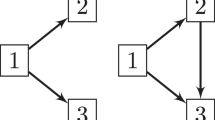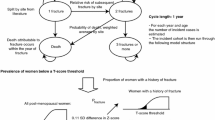Abstract
Vertebral fracture is a common consequence of osteoporosis for postmenopausal women. Modeling the progression of the disease in vertebral fractures has been of great interest to physicians as well as patients. In this paper, we propose a simple Markov chain model to study the progression of the vertebral fractures for untreated postmenopausal women with osteoporosis, in this model, the state space consists of {0, 1, 2,…13}, which represents the possible number of vertebral fractures for a patient, as commonly assessed via spinal x-ray. Based on the model, a simple estimator of the one-year transition probability matrix is proposed. An estimate for the m-year transition probability matrix is then derived following an application of the Chapman-kolmogorov equations. To estimate the confidence intervals for the m-year transition probabilities, a bootstrap procedure is proposed. The proposed bootstrap procedure can also be employed to construct confidence intervals for differences between two treatment groups. The methods are illustrated with data from clinical trials for an anti-resorptive therapy.
Similar content being viewed by others
References
Ross PD. Clinical consequence of vertebral fractures. Am J Med. 1997;103(suppl):30s–43s.
Lindsay R, Silverman SL, Cooper C, Hanley DA, Barton I, Broy SB, Licata A, Benhamou L, Geusens P, Flowers K, Stracke H, Seeman E. Risk of new vertebral fracture in the year following a fracture. JAMA. 2001;285:320–323.
Cox DR, Miller HD. The Theory of Stochastic Processes. London, United Kingdom: Methuen; 1965.
Chiang CL. An Introduction to Stochastic Processes and their Applications. New York, NY: Krieger; 1980.
Kalbfleisch JD, Lawless JF, Vollmer WM. Estimation in Markov models from aggregate data. Biometrics. 1983;39:907–919.
Reginster JY, Minne HW, Sorensen OH, Hooper M, Roux C, Brandi ML, Lund B, Ethgen D, Pack S, Roumagnac I, Eastell R. Randomized trial of the effects of risedronate on vertebral fractures in women with established postmenopausal osteoporosis. Osteoporosis Int. 2000;11:83–91.
Harris ST, Watts NB, Genant HK, McKeever CD, Hangartner T, Keller M, Chesnut C, Brown J, Eriksen EF, Hoseyni MS, Axelrod DW, Miller PD. Effects of risedronate treatment on vertebral and nonvertebral fractures in women with postmenopausal osteoporosis. JAMA. 1999;282:1344–1352.
McClung MR, Geusens P, Miller PD, et al. Effect of risedronate on the risk of hip fracture in elderly women. New Engl J Med. 2001;344:333–340.
Ross SM. Introduction to Probability Models. San Diego, CA: Academic Press; 1993.
Athreya KB, Fuh CD. Bootstrap Markov chains: countable case. J Stat Plan Inference. 1992; 33:311–331.
Author information
Authors and Affiliations
Corresponding author
Rights and permissions
About this article
Cite this article
Li, Z., Pack, S. An Application of Markov Models in Estimating Transition Probabilities for Postmenopausal Women with Osteoporosis. Ther Innov Regul Sci 38, 41–46 (2004). https://doi.org/10.1177/009286150403800106
Published:
Issue Date:
DOI: https://doi.org/10.1177/009286150403800106




